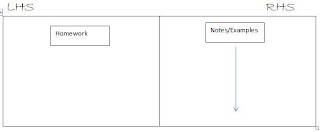I just finished my first week of school using interactive notebooks. I am on a block schedule, so I see students every other day except for one daily class (to split for lunches).
I feel like I am barely treading water. Everything is taking so much longer than normal. I am taking a cue from @mathequalslove and using the frayer model for vocab.
I have the vocab on the LHS, folded for students to use as a study guide. Our school is focusing on vocabulary, so I thought that this would integrate well with our focus. The students like how the model is folded, and that they can study with it.
I start with the "Bell Ringer" (warm up) and go right into vocab. The first day I did this, I gave them the sheet with the models, and students had to cut out the models. This took forever. After school, I found the paper cutter and cut about 100 sheets, and have since made 300 more copies (6 to a page). I still need to cut those. The 2nd day went better, time-wise. However, placement of the vocab was a nightmare. Did I tell them to put the vocab on the LHS? Some students heard it, and others didn't. So on the 2nd day, I made sure to emphasize where the vocab should go.
We didn't take notes the first day. I had them doing some classwork on dry-erase folders (Smart Pals). We went over the answers together. The second day, I used our interactive textbook feature, and had students write down specific problems. Again, confusion as to which problems to write down. I made sure to stress whish side I wanted them to write on (RHS for notes).
Here's my notebook, with just the problems written out. I didn't have a lot of room. I feel like I need a month to prepare exactly how I want my notebook to look, so I am ready to show them how theirs should look.
We did do a foldable as well for this day. We worked on the words of basic math operations. I printed this
template and had students fold and cut, and then using color markers, write the words they knew for different operations. I told them that as we find more words, we will continue to add them to this foldable. I didn't have a LHS to put it on, as the vocab took up too much room, so I had them past it on the previous RHS.

We finally got to some practice after this. I did hear a student say how they liked how we were doing hands on stuff (and my blog's name earned it's wings).












































